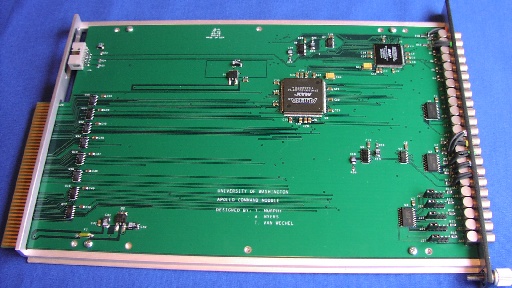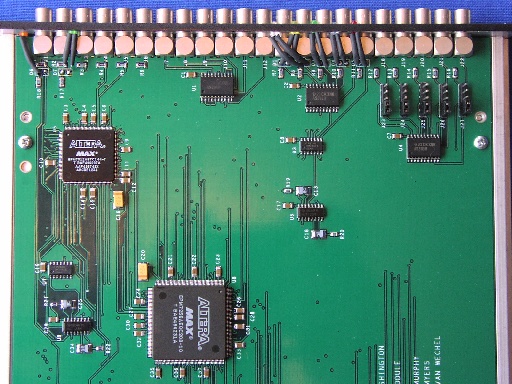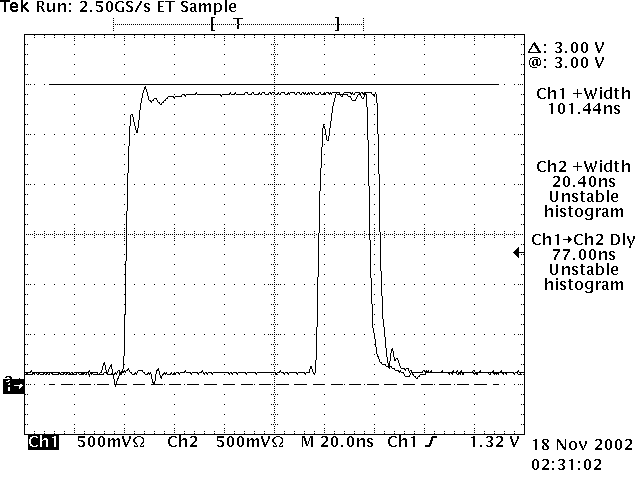Table of Contents
1. ACM Front Panel
2. ACM Module
3. Close-up view
4. ACM Waveform
1. ACM Front Panel

Working our way down the front panel, we have the following LEDs and connectors:
Dedicated Inputs
- N-LED indicates when the ACM is being addressed via the CAMAC dataway
- CLK input is the 50 MHz TTL square wave input, derived from the 5× multiplied 10 MHz output of our GPS-disciplined clock.
- 1_PPS input is the One Pulse-Per-Second output from the GPS clock, marking the exact beginning of each second (phase-locked to the 50 MHz). The associated (green) LED indicates a "pulse".
- PIN input is from the fast photodiode. This post-discrimination 100 ns TTL pulse indicates that the laser has fired.
- CAL input is an optional input requesting an APD gate-open. Ordinarily, this signal is generated from the PIN signal.
- IDX is the index input from the motor driving the T/R switch rotating optic. This announces the phase of the mirror in its rotation.
- ENC is the encoder input from the T/R switch motor, with 2000 TTL pulses per cycle. In combination with IDX, this signal informs the ACM when to fire the laser so that the laser hits the reflective patch on the rotating optic.
Dedicated Outputs
- LUN_ST is a 20-ns TTL whose rising edge is coincident with the turn-on of the APD gate associated with the lunar photon. This output is actually used to request TDC START events for the purpose of calibration.
- CAL_STis a 20-ns TTL whose rising edge is coincident with the turn-on of the APD gate associated with the laser fire (either via PIN or CAL prompts).
- OPN is a generic gate-open announcement, and represents the always-enabled OR combination of the previous two signals--any time the gate opens for any purpose.
- CLS is a 20-ns TTL announcing the gate is about to close. The gate shuts off with the trailing edge of this pulse. Thus OPN and CLS are nestled inside the gate pulse (which is a multiple of 20 ns long). See the example ACM waveform for a picture.
- STOP is the same as CLS, but specifically intended to request a STOP pulse for the TDC. Given propagation delays, the first clock pulse following gate closure is selected.
- TME is a 160-ns TTL sent to the XL-DC GPS clock upon the first CLS event within a given second (as announced by the 1_PPS signal). This signal latches the GPS time to the nearest microsecond.
- GTE is a TTL signal of variable duration (a multiple of 20 ns) coincident with the request for APD gate action. See the example ACM waveform for a picture. The associated (white) LED pulses with the gate (stretched).
- APD is an enabled version of GTE, and passes the gate request to the APD. The associated (yellow) LED indicates that the APD is enabled.
- LSR is a DC signal indicating that the laser is enabled. This signal also tells the laser to charge its capacitor bank. The associated (green) LED announces the high voltage state of this line.
- ZAP is a 50 µs TTL pulse requesting a fire event from the laser. The associated (blue) LED pulses with the fire request.
- BLK is a DC signal that requests blockage of the laser beam. Only if the voltage is high will the beam be unblocked. A red LED indicates when the beam is un-blocked.
Configurable Inputs/Outputs
These five connectors (I/O 1 through I/O 5) are jumper-configurable to act either as inputs to the TIMER chip, or can be outputs. One likely use will be to activate additional shutters or actuate deployable corner-cube prisms within the telescope.
2. ACM Module

A view of the ACM board, installed in its mechanical housing that slides into the CAMAC crate. The board itself is an 8-layer design, with generous ground planes and minimal signal-line overlap. From left to right are:
- The CAMAC double-sided edge-connector,
- Reprogramming port (upper-left) for reprogramming PLDs,
- input/output buffers,
- voltage regulators (lower-left and upper-center),
- the large PLD handling the CAMAC interface (commands, data I/O),
- the smaller (and faster) PLD for timing control and signal input/output,
- the front panel, with 22 LEMO connectors and a few LEDs.
3. Close-Up View

A view of the business-end of the ACM board. From top to bottom are:
- 6 input connectors, 11 output connectors, and 5 configurable input/output connectors (each with associated jumper determining input or output). The I/O connectors are for as-yet unassigned duties.
- Output buffers (three large-ish chips) for outputting TTL levels into 50-ohm loads.
- Jumpers for setting the mode of the 5 configurable I/O ports.
- The 144-pin EPM7512AE 7 ns Altera PLD handling the timing and state functions.
- One-shot, buffer combos (one in center, one lower left) to drive the LEDs on the front panel.
- The 208-pin EPM7256AE 10 ns Altera PLD defining the available command set, porting data to the CAMAC dataway, and setting operational parameters for the timing PLD.
4. ACM Waveform

This oscilloscope trace shows two of the ACM outputs. The wider pulse is the APD gate request (GTE), lasting 100 ns (this is tunable in multiples of 20 ns). (See the front panel description for definition of signals.) The shorter pulse tucked within the last bit of the gate pulse is the gate-close request (CLS), which results in shutting off the APD gate. The signals are very nicely square, and very clean in the digital sense. Various measurements are presented at right.










